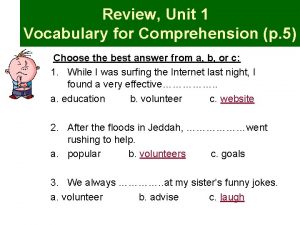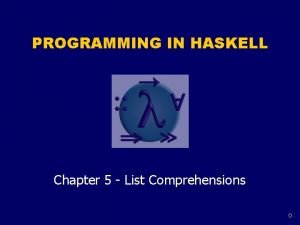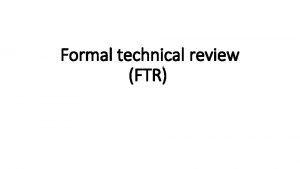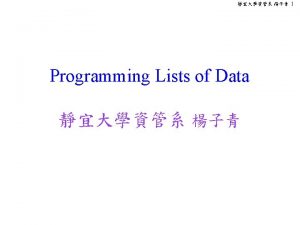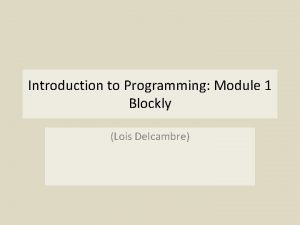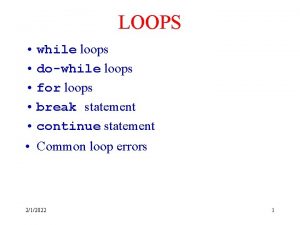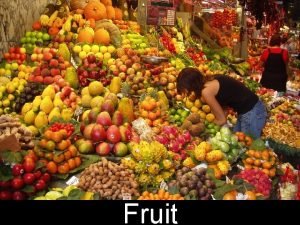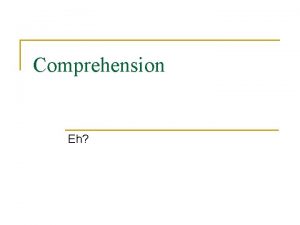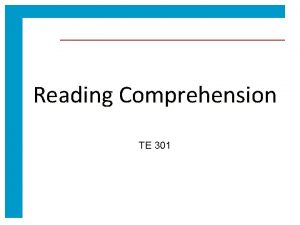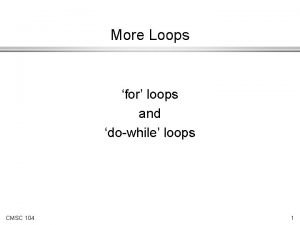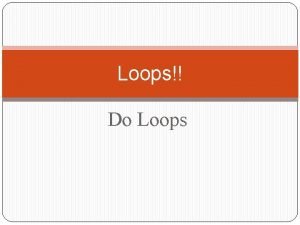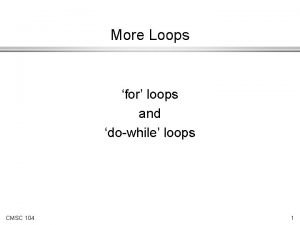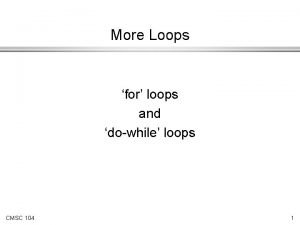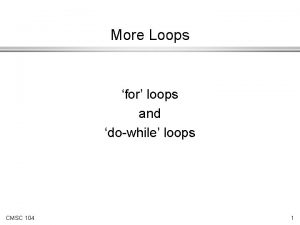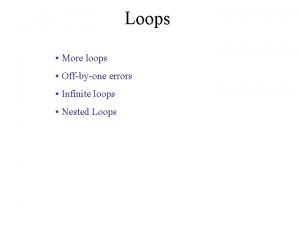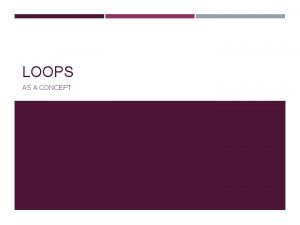List Comprehension Review Lists Loops Lists Loops fruit


![Lists & Loops fruit = [“apple”, “banana”, “carrot”] for element in fruit: print(element) Lists & Loops fruit = [“apple”, “banana”, “carrot”] for element in fruit: print(element)](https://slidetodoc.com/presentation_image_h/333fc89b417ef6af3fdaf871a0e4f700/image-3.jpg)


![Goal: [“apples”, “bananas”, “carrots”] fruit = [“apple”, “banana”, “carrot”] for element in fruit: print(element Goal: [“apples”, “bananas”, “carrots”] fruit = [“apple”, “banana”, “carrot”] for element in fruit: print(element](https://slidetodoc.com/presentation_image_h/333fc89b417ef6af3fdaf871a0e4f700/image-6.jpg)
![Goal: [“apples”, “bananas”, “carrots”] fruit = [“apple”, “banana”, “carrot”] morefruit = [ ] for Goal: [“apples”, “bananas”, “carrots”] fruit = [“apple”, “banana”, “carrot”] morefruit = [ ] for](https://slidetodoc.com/presentation_image_h/333fc89b417ef6af3fdaf871a0e4f700/image-7.jpg)
![Goal: [“apples”, “bananas”, “carrots”] fruit = [“apple”, “banana”, “carrot”] morefruit = [ ] 1. Goal: [“apples”, “bananas”, “carrots”] fruit = [“apple”, “banana”, “carrot”] morefruit = [ ] 1.](https://slidetodoc.com/presentation_image_h/333fc89b417ef6af3fdaf871a0e4f700/image-8.jpg)
![Goal: [“apples”, “bananas”, “carrots”] fruit = [“apple”, “banana”, “carrot”] morefruit =[element + “s” for Goal: [“apples”, “bananas”, “carrots”] fruit = [“apple”, “banana”, “carrot”] morefruit =[element + “s” for](https://slidetodoc.com/presentation_image_h/333fc89b417ef6af3fdaf871a0e4f700/image-9.jpg)
![Goal: [“apples”, “bananas”, “carrots”] fruit = [“apple”, “banana”, “carrot”] morefruit =[element + “s” for Goal: [“apples”, “bananas”, “carrots”] fruit = [“apple”, “banana”, “carrot”] morefruit =[element + “s” for](https://slidetodoc.com/presentation_image_h/333fc89b417ef6af3fdaf871a0e4f700/image-10.jpg)
![Goal: [“apples”, “bananas”, “carrots”] fruit = [“apple”, “banana”, “carrot”] morefruit =[element + “s” for Goal: [“apples”, “bananas”, “carrots”] fruit = [“apple”, “banana”, “carrot”] morefruit =[element + “s” for](https://slidetodoc.com/presentation_image_h/333fc89b417ef6af3fdaf871a0e4f700/image-11.jpg)
![Goal: [“apples”, “bananas”, “carrots”] fruit = [“apple”, “banana”, “carrot”] morefruit =[element + “s” for Goal: [“apples”, “bananas”, “carrots”] fruit = [“apple”, “banana”, “carrot”] morefruit =[element + “s” for](https://slidetodoc.com/presentation_image_h/333fc89b417ef6af3fdaf871a0e4f700/image-12.jpg)
![Goal: [1, 4, 9, 16, 25, 36, 49, 64, 81, 100] squares = [ Goal: [1, 4, 9, 16, 25, 36, 49, 64, 81, 100] squares = [](https://slidetodoc.com/presentation_image_h/333fc89b417ef6af3fdaf871a0e4f700/image-13.jpg)
![Goal: [1, 4, 9, 16, 25, 36, 49, 64, 81, 100] squares = [ Goal: [1, 4, 9, 16, 25, 36, 49, 64, 81, 100] squares = [](https://slidetodoc.com/presentation_image_h/333fc89b417ef6af3fdaf871a0e4f700/image-14.jpg)
![Goal: [1, 4, 9, 16, 25, 36, 49, 64, 81, 100] squares = [num Goal: [1, 4, 9, 16, 25, 36, 49, 64, 81, 100] squares = [num](https://slidetodoc.com/presentation_image_h/333fc89b417ef6af3fdaf871a0e4f700/image-15.jpg)
![Goal: [1, 4, 9, 16, 25, 36, 49, 64, 81, 100] squares = [num Goal: [1, 4, 9, 16, 25, 36, 49, 64, 81, 100] squares = [num](https://slidetodoc.com/presentation_image_h/333fc89b417ef6af3fdaf871a0e4f700/image-16.jpg)
![Goal: [1, 4, 9, 16, 25, 36, 49, 64, 81, 100] squares = [num Goal: [1, 4, 9, 16, 25, 36, 49, 64, 81, 100] squares = [num](https://slidetodoc.com/presentation_image_h/333fc89b417ef6af3fdaf871a0e4f700/image-17.jpg)
![Goal: [1, 4, 9, 16, 25, 36, 49, 64, 81, 100] squares = [num Goal: [1, 4, 9, 16, 25, 36, 49, 64, 81, 100] squares = [num](https://slidetodoc.com/presentation_image_h/333fc89b417ef6af3fdaf871a0e4f700/image-18.jpg)














- Slides: 32

List Comprehension

Review Lists & Loops
![Lists Loops fruit apple banana carrot for element in fruit printelement Lists & Loops fruit = [“apple”, “banana”, “carrot”] for element in fruit: print(element)](https://slidetodoc.com/presentation_image_h/333fc89b417ef6af3fdaf871a0e4f700/image-3.jpg)
Lists & Loops fruit = [“apple”, “banana”, “carrot”] for element in fruit: print(element)

Lists & Loops for i in range(20): print(i)

Little bit more complicated…
![Goal apples bananas carrots fruit apple banana carrot for element in fruit printelement Goal: [“apples”, “bananas”, “carrots”] fruit = [“apple”, “banana”, “carrot”] for element in fruit: print(element](https://slidetodoc.com/presentation_image_h/333fc89b417ef6af3fdaf871a0e4f700/image-6.jpg)
Goal: [“apples”, “bananas”, “carrots”] fruit = [“apple”, “banana”, “carrot”] for element in fruit: print(element + “s”) BUT THAT DOESN’T SAVE MY NEW LIST
![Goal apples bananas carrots fruit apple banana carrot morefruit for Goal: [“apples”, “bananas”, “carrots”] fruit = [“apple”, “banana”, “carrot”] morefruit = [ ] for](https://slidetodoc.com/presentation_image_h/333fc89b417ef6af3fdaf871a0e4f700/image-7.jpg)
Goal: [“apples”, “bananas”, “carrots”] fruit = [“apple”, “banana”, “carrot”] morefruit = [ ] for element in fruit: new = element + “s” morefruit. append(new) print(morefruit) 1. Start with an empty list 2. Create a new object in loop 3. Append new object to new list
![Goal apples bananas carrots fruit apple banana carrot morefruit 1 Goal: [“apples”, “bananas”, “carrots”] fruit = [“apple”, “banana”, “carrot”] morefruit = [ ] 1.](https://slidetodoc.com/presentation_image_h/333fc89b417ef6af3fdaf871a0e4f700/image-8.jpg)
Goal: [“apples”, “bananas”, “carrots”] fruit = [“apple”, “banana”, “carrot”] morefruit = [ ] 1. Start with an empty list 2. Create new object and append morefruit. append(element + “s”) AT THE SAME TIME print(morefruit) for element in fruit:
![Goal apples bananas carrots fruit apple banana carrot morefruit element s for Goal: [“apples”, “bananas”, “carrots”] fruit = [“apple”, “banana”, “carrot”] morefruit =[element + “s” for](https://slidetodoc.com/presentation_image_h/333fc89b417ef6af3fdaf871a0e4f700/image-9.jpg)
Goal: [“apples”, “bananas”, “carrots”] fruit = [“apple”, “banana”, “carrot”] morefruit =[element + “s” for element in fruit] print(morefruit) 1. Create list, object and append AT THE SAME TIME
![Goal apples bananas carrots fruit apple banana carrot morefruit element s for Goal: [“apples”, “bananas”, “carrots”] fruit = [“apple”, “banana”, “carrot”] morefruit =[element + “s” for](https://slidetodoc.com/presentation_image_h/333fc89b417ef6af3fdaf871a0e4f700/image-10.jpg)
Goal: [“apples”, “bananas”, “carrots”] fruit = [“apple”, “banana”, “carrot”] morefruit =[element + “s” for element in fruit] ~~~~~~~~~~~~~~~~~~~~~~~ morefruit = [ ] for element in fruit: morefruit. append(element + “s”)
![Goal apples bananas carrots fruit apple banana carrot morefruit element s for Goal: [“apples”, “bananas”, “carrots”] fruit = [“apple”, “banana”, “carrot”] morefruit =[element + “s” for](https://slidetodoc.com/presentation_image_h/333fc89b417ef6af3fdaf871a0e4f700/image-11.jpg)
Goal: [“apples”, “bananas”, “carrots”] fruit = [“apple”, “banana”, “carrot”] morefruit =[element + “s” for element in fruit] ~~~~~~~~~~~~~~~~~~~~~~~ morefruit = [ ] for element in fruit: morefruit. append(element + “s”)
![Goal apples bananas carrots fruit apple banana carrot morefruit element s for Goal: [“apples”, “bananas”, “carrots”] fruit = [“apple”, “banana”, “carrot”] morefruit =[element + “s” for](https://slidetodoc.com/presentation_image_h/333fc89b417ef6af3fdaf871a0e4f700/image-12.jpg)
Goal: [“apples”, “bananas”, “carrots”] fruit = [“apple”, “banana”, “carrot”] morefruit =[element + “s” for element in fruit] ~~~~~~~~~~~~~~~~~~~~~~~ morefruit = [ ] for element in fruit: morefruit. append(element + “s”)
![Goal 1 4 9 16 25 36 49 64 81 100 squares Goal: [1, 4, 9, 16, 25, 36, 49, 64, 81, 100] squares = [](https://slidetodoc.com/presentation_image_h/333fc89b417ef6af3fdaf871a0e4f700/image-13.jpg)
Goal: [1, 4, 9, 16, 25, 36, 49, 64, 81, 100] squares = [ ] for num in range(1, 11): new = num ** 2 squares. append(new) print(squares) 1. Start with an empty list 2. Create a new object in loop 3. Append new object to new list
![Goal 1 4 9 16 25 36 49 64 81 100 squares Goal: [1, 4, 9, 16, 25, 36, 49, 64, 81, 100] squares = [](https://slidetodoc.com/presentation_image_h/333fc89b417ef6af3fdaf871a0e4f700/image-14.jpg)
Goal: [1, 4, 9, 16, 25, 36, 49, 64, 81, 100] squares = [ ] for num in range(1, 11): squares. append(num ** 2) print(squares) 1. Start with an empty list 2. Create new object and append AT THE SAME TIME
![Goal 1 4 9 16 25 36 49 64 81 100 squares num Goal: [1, 4, 9, 16, 25, 36, 49, 64, 81, 100] squares = [num](https://slidetodoc.com/presentation_image_h/333fc89b417ef6af3fdaf871a0e4f700/image-15.jpg)
Goal: [1, 4, 9, 16, 25, 36, 49, 64, 81, 100] squares = [num ** 2 for num in range(1, 11)] print(squares) 1. Create list, object and append AT THE SAME TIME
![Goal 1 4 9 16 25 36 49 64 81 100 squares num Goal: [1, 4, 9, 16, 25, 36, 49, 64, 81, 100] squares = [num](https://slidetodoc.com/presentation_image_h/333fc89b417ef6af3fdaf871a0e4f700/image-16.jpg)
Goal: [1, 4, 9, 16, 25, 36, 49, 64, 81, 100] squares = [num ** 2 for num in range(1, 11)] print(squares) ~~~~~~~~~~~~~~~~~~~~ squares = [ ] for num in range(1, 11): squares. append(num ** 2)
![Goal 1 4 9 16 25 36 49 64 81 100 squares num Goal: [1, 4, 9, 16, 25, 36, 49, 64, 81, 100] squares = [num](https://slidetodoc.com/presentation_image_h/333fc89b417ef6af3fdaf871a0e4f700/image-17.jpg)
Goal: [1, 4, 9, 16, 25, 36, 49, 64, 81, 100] squares = [num ** 2 for num in range(1, 11)] print(squares) ~~~~~~~~~~~~~~~~~~~~ squares = [ ] for num in range(1, 11): squares. append(num ** 2)
![Goal 1 4 9 16 25 36 49 64 81 100 squares num Goal: [1, 4, 9, 16, 25, 36, 49, 64, 81, 100] squares = [num](https://slidetodoc.com/presentation_image_h/333fc89b417ef6af3fdaf871a0e4f700/image-18.jpg)
Goal: [1, 4, 9, 16, 25, 36, 49, 64, 81, 100] squares = [num ** 2 for num in range(1, 11)] print(squares) ~~~~~~~~~~~~~~~~~~~~ squares = [ ] for num in range(1, 11): squares. append(num ** 2)

GOAL: create list of decimals from 0 to 0. 50 wholenum = list(range(51)) decs = [ ] for number in wholenum: small = number/100 decs. append(small) print(decs) 1. Start with an empty list 2. Create a new object in loop 3. Append new object to new list

GOAL: create list of decimals from 0 to 0. 50 wholenum = list(range(51)) decs = [ ] for number in wholenum: decs. append(number/100) print(decs) 1. Start with an empty list 2. Create new object and append AT THE SAME TIME

GOAL: create list of decimals from 0 to 0. 50 wholenum = list(range(51)) decs = [number/100 for number in wholenum] print(decs) 1. Create list, object and append AT THE SAME TIME

GOAL: create list of decimals from 0 to 0. 50 wholenum = list(range(51)) decs = [number/100 for number in wholenum] print(decs) ~~~~~~~~~~~~~~~~~~~ decs = [ ] for number in wholenum: decs. append(number/100)

GOAL: create list of decimals from 0 to 0. 50 wholenum = list(range(51)) decs = [number/100 for number in wholenum] print(decs) ~~~~~~~~~~~~~~~~~~~ decs = [ ] for number in wholenum: decs. append(number/100)

GOAL: create list of decimals from 0 to 0. 50 wholenum = list(range(51)) decs = [number/100 for number in wholenum] print(decs) ~~~~~~~~~~~~~~~~~~~ decs = [ ] for number in wholenum: decs. append(number/100)

Goal: Find numbers greater than 100 in a list. mylist = [1, 78, 123, 73, 98, 101, 805] biglist = [ ] for x in mylist: if x > 100: biglist. append(x) print(biglist) 1. Start with an empty list 2. Check if its bigger than 100 3. If so, add it to the big list

Goal: Find numbers greater than 100 in a list. mylist = [1, 78, 123, 73, 98, 101, 805] biglist = [x for x in mylist if x > 100] print(biglist) 1. Create a list, check if x is bigger than 100 and add it if it is.

Goal: Find numbers greater than 100 in a list. mylist = [1, 78, 123, 73, 98, 101, 805] biglist = [x for x in mylist if x > 100] print(biglist) ~~~~~~~~~~~~~~~~~~~~~~ biglist = [ ] for x in mylist: if x > 100: biglist. append(x)

Goal: Find numbers greater than 100 in a list. mylist = [1, 78, 123, 73, 98, 101, 805] biglist = [x for x in mylist if x > 100] print(biglist) ~~~~~~~~~~~~~~~~~~~~~~ biglist = [ ] for x in mylist: if x > 100: biglist. append(x)

Goal: Find numbers greater than 100 in a list. mylist = [1, 78, 123, 73, 98, 101, 805] biglist = [x for x in mylist if x > 100] print(biglist) ~~~~~~~~~~~~~~~~~~~~~~ biglist = [ ] for x in mylist: if x > 100: biglist. append(x)

Goal: Find numbers greater than 100 in a list. mylist = [1, 78, 123, 73, 98, 101, 805] biglist = [x for x in mylist if x > 100] print(biglist) ~~~~~~~~~~~~~~~~~~~~~~ biglist = [ ] for x in mylist: if x > 100: biglist. append(x)

littlelists. py For each task: 1) do in loop and 2) do in list comprehension “The quick brown fox jumped over the lazy dog” 1. 2. 3. 4. Count the number of spaces in the above string. Find all the words that have the letter “o” in the above string Find all the words that have at least 5 letters in the above string Find all the numbers from 1 to 1000 that have a “ 3” in it. Ex: 23, 37, 903

genecomprehension. py GOAL: Determine length of large genes on m. RNA strand Assumptions: Genes are recognized as segments of RNA separated by start codon AUG 1. Generate a random RNA sequence into a STRING 1000 base pairs long 2. Create list of genes that are separated by start codon 3. Create list of large genes (>50 bp) using LIST COMPREHENSION 4. Determine length of large genes • * If your 1 st fragment in #2 does not start with AUG (which is probably won’t), do not try to overcomplicate this. Just consider it one of the fragments and proceed forward….
 Statolith in plants
Statolith in plants Fruit vegetable definition
Fruit vegetable definition Parts of a peach
Parts of a peach Lecture about flowers
Lecture about flowers Python plot list of lists
Python plot list of lists Prolog list of lists
Prolog list of lists Review units 1-3 vocabulary for comprehension
Review units 1-3 vocabulary for comprehension Haskell list comprehension
Haskell list comprehension List comprehension haskell
List comprehension haskell Chapter review motion part a vocabulary review answer key
Chapter review motion part a vocabulary review answer key Uncontrollable spending ap gov
Uncontrollable spending ap gov Nader amin-salehi
Nader amin-salehi Systematic review definition
Systematic review definition Narrative review vs systematic review
Narrative review vs systematic review List the objectives of a formal technical review.
List the objectives of a formal technical review. Axiomatic structure
Axiomatic structure Singly vs doubly linked list
Singly vs doubly linked list Singly vs doubly linked list
Singly vs doubly linked list List g shows list of
List g shows list of Pengertian single linked list
Pengertian single linked list Select list item list index too large
Select list item list index too large While loops and if-else structures
While loops and if-else structures Pulmonary function test results
Pulmonary function test results Sun means
Sun means Matlab break nested loop
Matlab break nested loop Types of loops in matlab
Types of loops in matlab Programming puzzle
Programming puzzle Perulangan looping
Perulangan looping Geothermal loops design
Geothermal loops design Matlab for loop example problems
Matlab for loop example problems Cakewalk loops
Cakewalk loops Intestinal obstruction classification
Intestinal obstruction classification Branch loop node formula
Branch loop node formula






